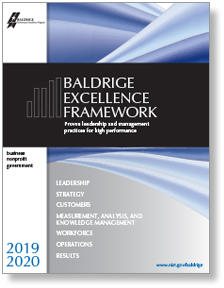Blogrige
The Official Baldrige Blog

In a recent blog, entitled The New Normal Will Require RE2ST3, I asserted two of the components of the new normal will be transition and transformation. But, how do you prepare strategically for transitions and organizational transformation, particularly in an environment of significant uncertainty? That is the topic of this blog post.
The challenge all organizations face in the establishment of a new normal following the upheavals of 2020 is how to make rational decisions when so much is unknown about the future. I believe the place to start is by the examination of the data we have available.
Examination of Data
Einhorn in a recent HBR blog defines three types of data: salient data, contextual data, and patterned data. Each type of data is subject to an interpretive bias that we must address as we prepare to do strategic planning. I think this is particularly necessary in times of upheaval.
Salient data comprise noteworthy or surprising data that capture our attention. Examples would be the recent, severe declines in airline travel and hotel bookings. In April 2020 airline travel was down 94% relative to a year earlier. The tendency to overweight salient data could lead to biased conclusions, for example that there is no future for air travel.
Contextual data are data presented in a way that could affect how we interpret it. The classic example is seeing a glass half empty vs. half full. How data are presented can impact our interpretation of the meaning and significance of the data.
Patterned data are trend data that seem to have a meaningful form. We need to be careful not to look for trends that are due to random events or limited by the timeframe examined. For example, looking at airline travel and trending data only for the last half year would lead to the conclusion that airline travel is likely to stay very low.
Data gathering is a critical first step in planning. However, particularly in times of great change, we must be careful in data interpretation to not be influenced by near-term biases.
Strategic Planning
I believe there are several options for proceeding once the data have been interpreted and the environment scanned. I have suggested a few below.
To start, we must remember that every cloud has a silver lining. And every crisis also presents us with a crisis of opportunity that should be considered for strategic pursuit. As El-Erian points out in a recent Project Syndicate Newsletter, in responding to the pandemic we are living through a period of rapid invention and innovation. Scientists around the world are sharing information. New collaborations among former competitors are extensive. Dynamic public-private collaborations are expanding ecosystem possibilities for the future. Two examples of these recent collaborations are the work on vaccine development and the collaborations to achieve community-wide broadband access. These silver linings should be exploited for the future.
Caffaro in a Lead Change blog points out that COVID-19 has given organizations great insight into what was not working well. He suggests that we examine those shortcomings for opportunities to innovate. He also recommends that we reexamine our organization's vision to see if it still fits. If not, restate that vision and refine plans and operations accordingly.
Different organizations and industries will have varying degrees of uncertainty going forward. Organizations need to assess their level of uncertainty and then choose a planning model. If your future is pretty clear, use classic approaches to strategic planning. If you envision a limited number of situations, scenario planning may be appropriate. Coutney, Kirkland, and Viguerie in a classic Harvard Business Review article from 1997 comment on planning in a highly uncertain environment. They suggest using technology forecasting and scenario planning in combination with selecting a strategic posture for your organization. Will you be shaping your industry's future, will you be adapting to change, or will you make incremental investments that keep you poised to make a commitment to a particular strategy in the future? Build a portfolio of strategic moves based on your chosen posture. The authors suggest the option of big bets if you want to be at the forefront, more limited bets if you want to enable ramp up or scale back as the environment evolves, or no-regrets moves if you only want to currently exercise actions that pay off in any future.
In extreme uncertainty, one approach to planning is referred to by Deloitte as Zoom Out/Zoom In. Zoom out to the 10-20 year horizon; this expands your horizons beyond any current constraints. What kind of organization do you want to be in 20 years? What might your industry and society look like? Then zoom in on the next 6-12 months and explore the highest priority things you can do now and stop doing now to meet your 20-year vision. Finally, reassess on a regular basis to become agile and resilient. This approach to planning removes any blind spots due to current uncertainty and doubts.
Can Baldrige Help?
The Baldrige Excellence Framework Criteria category 2 on Strategy starts with three fundamental considerations that can help you with your options:
- How will you collect and analyze relevant data and information for use in your strategic planning? How will you consider key elements of risk?
- How will you conduct your strategic planning?
- How will you incorporate innovation?
Within the Criteria's series of detailed questions about how you conduct your strategic planning, there is a specific question:
- How does your strategic planning process address the potential need for transformational change, prioritization of change initiatives, and organizational agility?
Our state of uncertainty will definitely continue for the near future. However, that is not a reason to sit still and wait. The time to start gathering information and planning is now, no matter what posture you choose.

Baldrige Excellence Framework
The Baldrige Excellence Framework has empowered organizations to accomplish their missions, improve results, and become more competitive. It includes the Criteria for Performance Excellence, core values and concepts, and guidelines for evaluating your processes and results.
Purchase your copy today!
Available versions: Business/Nonprofit, Education, and Health Care
About the author
Related Posts
Comments
keep sharing this type of informative content. I actually like the content very much. This is a very informative content.






Hi, I am glad that I have gone through such an astonishing post, Thanks for sharing !